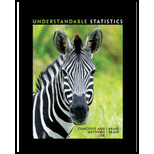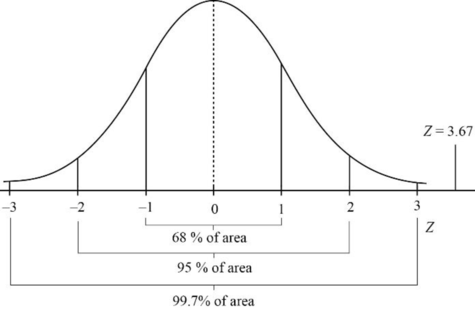
Concept explainers
(a)
Find the z interval for 4.5<x.
(a)
Answer to Problem 11P
The z interval for 4.5<x is z>−1.00.
Explanation of Solution
Calculation:
Z score:
The number of standard deviations the original measurement x is from the value of mean μ is measured using the z-score or z value. The formula for z score is,
z=x−μσ
In the formula, x is the raw score, μ is the mean and σ is the standard deviation.
The variable x is red blood cell (RBC) count in millions per cubic millimetre for women. The healthy females are
z=x−4.80.3
For the z interval consider,
4.5<xx>4.5
Subtract 4.8 on both sides of the inequality.
x−4.8>4.5−4.8x−4.8>−0.3
Divide 0.3 on both sides of the inequality.
x−4.80.3>−0.30.3z>−1.00
Hence, the z interval for 4.5<x is z>−1.00.
(b)
Find the z interval for x<4.2.
(b)
Answer to Problem 11P
The z interval for x<4.2 is z<−2.00.
Explanation of Solution
Calculation:
For the z interval consider,
x<4.2
Subtract 4.8 on both sides of the inequality.
x−4.8<4.2−4.8x−4.8<−0.6
Divide 0.3 on both sides of the inequality.
x−4.80.3<−0.60.3z<−2.00
Hence, the z interval for x<4.2 is z<−2.00.
(c)
Find the z interval for 4.0<x<5.5.
(c)
Answer to Problem 11P
The z interval for 4.0<x<5.5 is −2.67<z<2.33.
Explanation of Solution
Calculation:
For the z interval consider,
4.0<x<5.5
Subtract 4.8 for each part of the inequality.
4.0−4.8<x−4.8<5.5−4.8−0.8<x−4.8<0.7
Divide 4.3 for each part of the inequality.
−0.80.3<x−4.80.3<0.70.3−2.67<z<2.33
Hence, the z interval for 4.0<x<5.5 is −2.67<z<2.33.
(d)
Find the x interval for z<−1.44.
(d)
Answer to Problem 11P
The x interval for z<−1.44 is x<4.4.
Explanation of Solution
Calculation:
The z score is,
z=x−4.80.3x=4.8+0.3z
For the x interval consider,
z<−1.44
Multiply 0.3 on both sides of the inequality.
0.3z<−1.44(0.3)0.3z<−0.432
Add 4.8 on both sides of the inequality.
4.8+0.3z<−0.432+4.8x<4.4
Hence, the x interval for z<−1.44 is x<4.4.
(e)
Find the x interval for 1.28<z.
(e)
Answer to Problem 11P
The x interval for 1.28<z is x>5.2.
Explanation of Solution
Calculation:
For the x interval consider,
1.28<zz>1.28
Multiply 0.3 on both sides of the inequality.
0.3z>1.28(0.3)0.3z>0.384
Add 4.8 on both sides of the inequality.
4.8+0.3z>0.384+4.8x>5.2
Hence, the x interval for 1.28<z is x>5.2.
(f)
Find the x interval for −2.25<z<−1.00.
(f)
Answer to Problem 11P
The x interval for −2.25<z<−1.00 is 4.12<x<4.50.
Explanation of Solution
Calculation:
For the x interval consider,
−2.25<z<−1.00
Multiply 0.3 for each part of the inequality.
−2.25(0.3)<0.3z<−1.00(0.3)−0.675<0.3z<−0.300
Add 4.8 for each part of the inequality.
−0.675+4.8<4.8+0.3z<−0.300+4.84.12<x<4.50
Hence, the x interval for −2.25<z<−1.00 is 4.12<x<4.50.
(g)
Identify whether the RBC count of 5.9 or higher can be considered unusually high or not using z values and Figure 6-15.
(g)
Answer to Problem 11P
The RBC count of 5.9 or higher is unusually high.
Explanation of Solution
Calculation:
The RBC count of 5.9 or higher, that is x≥5.9. Then the value of z is,
x≥5.9
Subtract 4.8 on both sides of the inequality.
x−4.8≥5.9−4.8x−4.8≥1.1
Divide 0.3 on both sides of the inequality.
x−4.80.3≥1.10.3z≥3.67
The RBC count of 5.9 or higher is 3.67 standard deviations above the mean value. The z score value is greater than 3 indicating that the value is very unusual.
The figure 6-15 is the standard normal distribution curve. The z value is located on the curve as below.

The z value that is far from the mean (zero) is considered as unusual. If the value is closer to –3 is usually very small and value closer to 3 is usually very large.
If the value of z for RBC count of 5.9 or higher is greater to 3 then RBC count would be very large and unusual.
Want to see more full solutions like this?
Chapter 6 Solutions
WebAssign Printed Access Card for Brase/Brase's Understandable Statistics: Concepts and Methods, 12th Edition, Single-Term
- In this problem, we consider a Brownian motion (W+) t≥0. We consider a stock model (St)t>0 given (under the measure P) by d.St 0.03 St dt + 0.2 St dwt, with So 2. We assume that the interest rate is r = 0.06. The purpose of this problem is to price an option on this stock (which we name cubic put). This option is European-type, with maturity 3 months (i.e. T = 0.25 years), and payoff given by F = (8-5)+ (a) Write the Stochastic Differential Equation satisfied by (St) under the risk-neutral measure Q. (You don't need to prove it, simply give the answer.) (b) Give the price of a regular European put on (St) with maturity 3 months and strike K = 2. (c) Let X = S. Find the Stochastic Differential Equation satisfied by the process (Xt) under the measure Q. (d) Find an explicit expression for X₁ = S3 under measure Q. (e) Using the results above, find the price of the cubic put option mentioned above. (f) Is the price in (e) the same as in question (b)? (Explain why.)arrow_forwardProblem 4. Margrabe formula and the Greeks (20 pts) In the homework, we determined the Margrabe formula for the price of an option allowing you to swap an x-stock for a y-stock at time T. For stocks with initial values xo, yo, common volatility σ and correlation p, the formula was given by Fo=yo (d+)-x0Þ(d_), where In (±² Ꭲ d+ õ√T and σ = σ√√√2(1 - p). дго (a) We want to determine a "Greek" for ỡ on the option: find a formula for θα (b) Is дго θα positive or negative? (c) We consider a situation in which the correlation p between the two stocks increases: what can you say about the price Fo? (d) Assume that yo< xo and p = 1. What is the price of the option?arrow_forwardWe consider a 4-dimensional stock price model given (under P) by dẴ₁ = µ· Xt dt + йt · ΣdŴt where (W) is an n-dimensional Brownian motion, π = (0.02, 0.01, -0.02, 0.05), 0.2 0 0 0 0.3 0.4 0 0 Σ= -0.1 -4a За 0 0.2 0.4 -0.1 0.2) and a E R. We assume that ☑0 = (1, 1, 1, 1) and that the interest rate on the market is r = 0.02. (a) Give a condition on a that would make stock #3 be the one with largest volatility. (b) Find the diversification coefficient for this portfolio as a function of a. (c) Determine the maximum diversification coefficient d that you could reach by varying the value of a? 2arrow_forward
- Question 1. Your manager asks you to explain why the Black-Scholes model may be inappro- priate for pricing options in practice. Give one reason that would substantiate this claim? Question 2. We consider stock #1 and stock #2 in the model of Problem 2. Your manager asks you to pick only one of them to invest in based on the model provided. Which one do you choose and why ? Question 3. Let (St) to be an asset modeled by the Black-Scholes SDE. Let Ft be the price at time t of a European put with maturity T and strike price K. Then, the discounted option price process (ert Ft) t20 is a martingale. True or False? (Explain your answer.) Question 4. You are considering pricing an American put option using a Black-Scholes model for the underlying stock. An explicit formula for the price doesn't exist. In just a few words (no more than 2 sentences), explain how you would proceed to price it. Question 5. We model a short rate with a Ho-Lee model drt = ln(1+t) dt +2dWt. Then the interest rate…arrow_forwardIn this problem, we consider a Brownian motion (W+) t≥0. We consider a stock model (St)t>0 given (under the measure P) by d.St 0.03 St dt + 0.2 St dwt, with So 2. We assume that the interest rate is r = 0.06. The purpose of this problem is to price an option on this stock (which we name cubic put). This option is European-type, with maturity 3 months (i.e. T = 0.25 years), and payoff given by F = (8-5)+ (a) Write the Stochastic Differential Equation satisfied by (St) under the risk-neutral measure Q. (You don't need to prove it, simply give the answer.) (b) Give the price of a regular European put on (St) with maturity 3 months and strike K = 2. (c) Let X = S. Find the Stochastic Differential Equation satisfied by the process (Xt) under the measure Q. (d) Find an explicit expression for X₁ = S3 under measure Q. (e) Using the results above, find the price of the cubic put option mentioned above. (f) Is the price in (e) the same as in question (b)? (Explain why.)arrow_forwardThe managing director of a consulting group has the accompanying monthly data on total overhead costs and professional labor hours to bill to clients. Complete parts a through c. Question content area bottom Part 1 a. Develop a simple linear regression model between billable hours and overhead costs. Overhead Costsequals=212495.2212495.2plus+left parenthesis 42.4857 right parenthesis42.485742.4857times×Billable Hours (Round the constant to one decimal place as needed. Round the coefficient to four decimal places as needed. Do not include the $ symbol in your answers.) Part 2 b. Interpret the coefficients of your regression model. Specifically, what does the fixed component of the model mean to the consulting firm? Interpret the fixed term, b 0b0, if appropriate. Choose the correct answer below. A. The value of b 0b0 is the predicted billable hours for an overhead cost of 0 dollars. B. It is not appropriate to interpret b 0b0, because its value…arrow_forward
- Using the accompanying Home Market Value data and associated regression line, Market ValueMarket Valueequals=$28,416+$37.066×Square Feet, compute the errors associated with each observation using the formula e Subscript ieiequals=Upper Y Subscript iYiminus−ModifyingAbove Upper Y with caret Subscript iYi and construct a frequency distribution and histogram. LOADING... Click the icon to view the Home Market Value data. Question content area bottom Part 1 Construct a frequency distribution of the errors, e Subscript iei. (Type whole numbers.) Error Frequency minus−15 comma 00015,000less than< e Subscript iei less than or equals≤minus−10 comma 00010,000 0 minus−10 comma 00010,000less than< e Subscript iei less than or equals≤minus−50005000 5 minus−50005000less than< e Subscript iei less than or equals≤0 21 0less than< e Subscript iei less than or equals≤50005000 9…arrow_forwardThe managing director of a consulting group has the accompanying monthly data on total overhead costs and professional labor hours to bill to clients. Complete parts a through c Overhead Costs Billable Hours345000 3000385000 4000410000 5000462000 6000530000 7000545000 8000arrow_forwardUsing the accompanying Home Market Value data and associated regression line, Market ValueMarket Valueequals=$28,416plus+$37.066×Square Feet, compute the errors associated with each observation using the formula e Subscript ieiequals=Upper Y Subscript iYiminus−ModifyingAbove Upper Y with caret Subscript iYi and construct a frequency distribution and histogram. Square Feet Market Value1813 911001916 1043001842 934001814 909001836 1020002030 1085001731 877001852 960001793 893001665 884001852 1009001619 967001690 876002370 1139002373 1131001666 875002122 1161001619 946001729 863001667 871001522 833001484 798001589 814001600 871001484 825001483 787001522 877001703 942001485 820001468 881001519 882001518 885001483 765001522 844001668 909001587 810001782 912001483 812001519 1007001522 872001684 966001581 86200arrow_forward
 Glencoe Algebra 1, Student Edition, 9780079039897...AlgebraISBN:9780079039897Author:CarterPublisher:McGraw Hill
Glencoe Algebra 1, Student Edition, 9780079039897...AlgebraISBN:9780079039897Author:CarterPublisher:McGraw Hill Big Ideas Math A Bridge To Success Algebra 1: Stu...AlgebraISBN:9781680331141Author:HOUGHTON MIFFLIN HARCOURTPublisher:Houghton Mifflin Harcourt
Big Ideas Math A Bridge To Success Algebra 1: Stu...AlgebraISBN:9781680331141Author:HOUGHTON MIFFLIN HARCOURTPublisher:Houghton Mifflin Harcourt Holt Mcdougal Larson Pre-algebra: Student Edition...AlgebraISBN:9780547587776Author:HOLT MCDOUGALPublisher:HOLT MCDOUGAL
Holt Mcdougal Larson Pre-algebra: Student Edition...AlgebraISBN:9780547587776Author:HOLT MCDOUGALPublisher:HOLT MCDOUGAL- Algebra & Trigonometry with Analytic GeometryAlgebraISBN:9781133382119Author:SwokowskiPublisher:Cengage
 Functions and Change: A Modeling Approach to Coll...AlgebraISBN:9781337111348Author:Bruce Crauder, Benny Evans, Alan NoellPublisher:Cengage Learning
Functions and Change: A Modeling Approach to Coll...AlgebraISBN:9781337111348Author:Bruce Crauder, Benny Evans, Alan NoellPublisher:Cengage Learning





